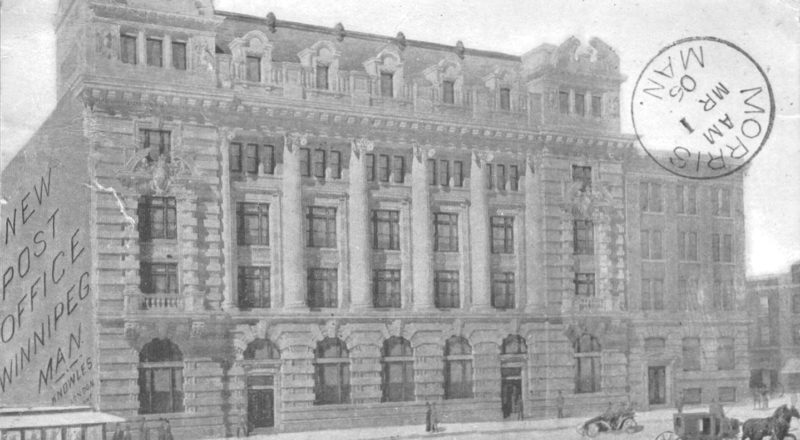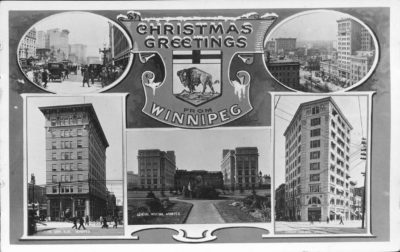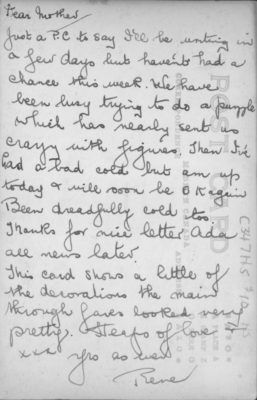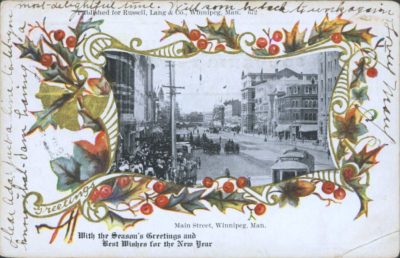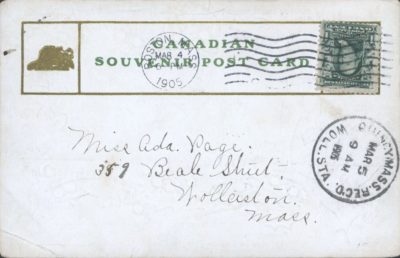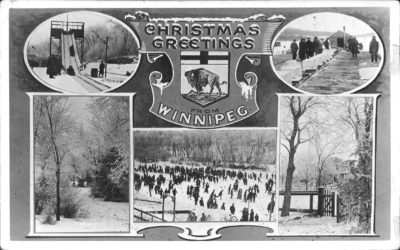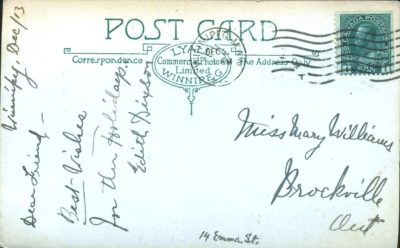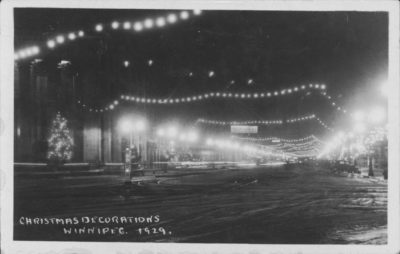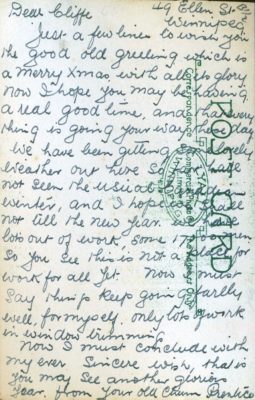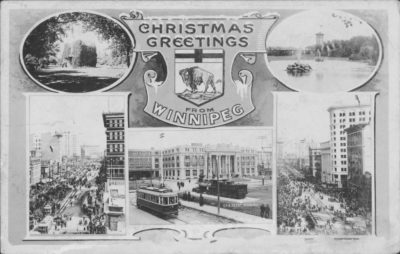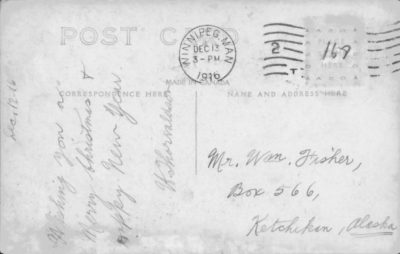
/ Blog
December 22, 2023
Delivering The Holidays: Winnipeg’s Post Offices
December is a special time of year when regardless of our beliefs, we slow down and connect with people we love. Many of us will go through the ritual of sending Christmas cards, recapping the happenings of the year, and include a picture or two to share with friends and family. It is a tradition filled with nostalgia and warmth, putting a stamp on an envelope and sending a letter in the mail, knowing it will bring joy. For Canada’s postal system, its peak season runs from the end of October to the middle of January, sometimes delivering more than two million parcels in one day! Along with all the hardworking individuals who go above and beyond to ensure our mail is delivered on time, there are post offices, the buildings where all the action takes place.
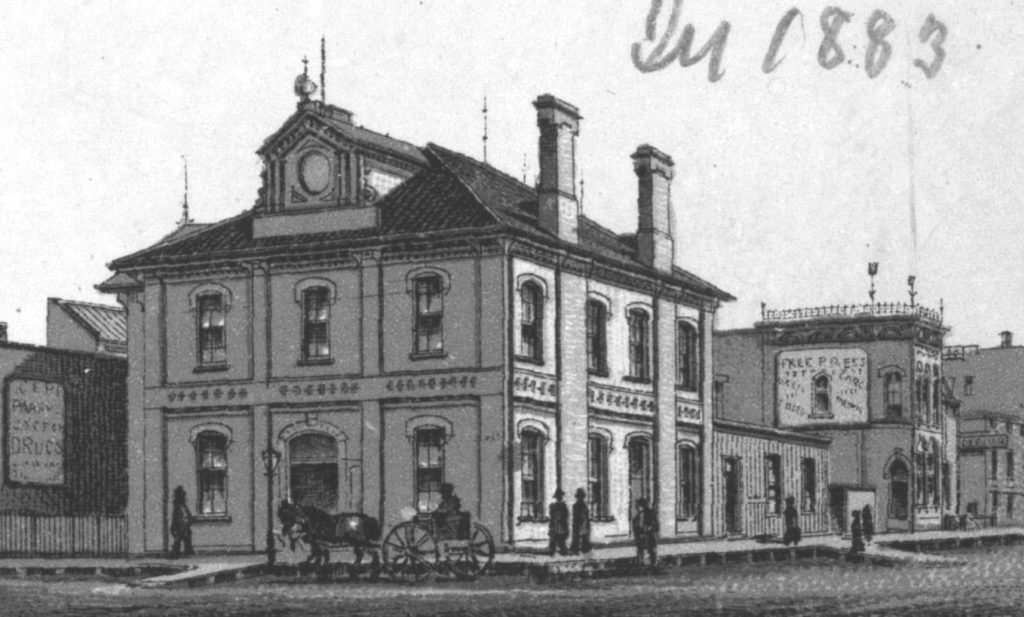
Winnipeg’s 1876 post office at the corner of McDermot Avenue and Main Street.
Source: Manitoba Historical Maps from Canada (CC BY 2.0, via Wikimedia Commons)
The early roots of the postal system can be traced back over 4000 years to ancient Egypt when good communication was essential to governing an empire. In the centuries and millennia that followed, simple systems became more complicated, building connections worldwide. In today’s modern era of electronic communication that allows us to send words, pictures, and even video chat with whoever whenever, the postal system persists. What is it about mail that has stood the test of time? Slow-paced and tangible, for some things there is just no electronic replacement, not only for the object, but for the message it conveys. In this festive season, when we pause to think about our loved ones and put in the extra effort to spread happiness, the postal system is indispensable. Season’s greetings, gifts, donations, thank you’s and even returns, we send it all in the mail, the system that makes the holidays happen.
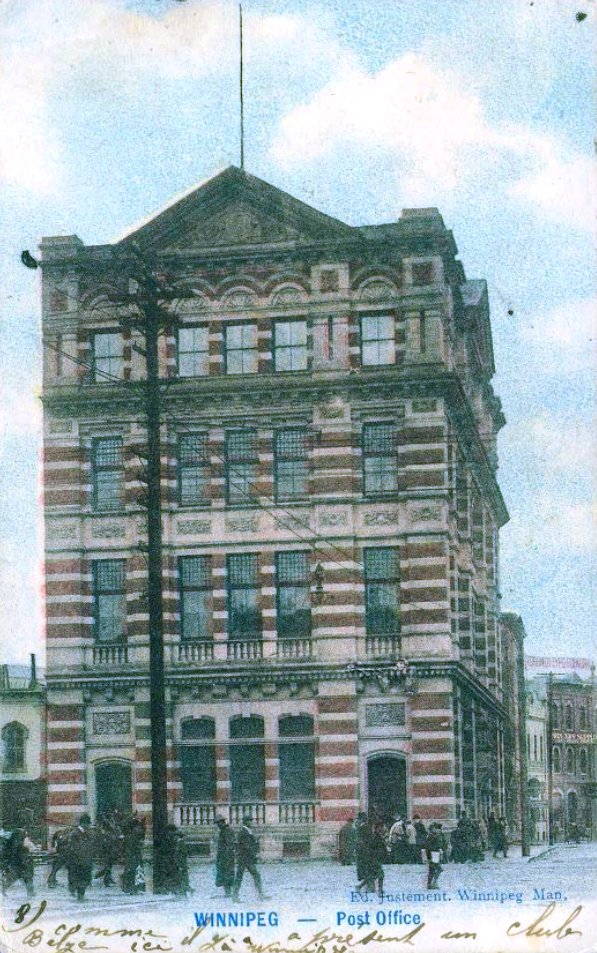
A post card showing Winnipeg’s 1886 post office at 401 Main Street in the early 20th century.
Source: The Rob McInnes Postcard Collection (Winnipeg Public Library)
Canada’s first official post office opened in 1753 in Halifax, connecting the east coast to the United Kingdom. Post offices ensure the collection, sorting, and delivery of mail, and are generally operated by the government. Along with facilitating the mail, post offices in many countries have expanded to provide other services, including banking, collecting taxes and even distributing antimalarial drugs. Their ever-evolving nature ensures they are just as critical to modern life as they were when first put into operation hundreds of years ago! The oldest continuously operating post office in the world is the Sanquhar Post Office in the United Kingdom, which first opened its doors in 1712.
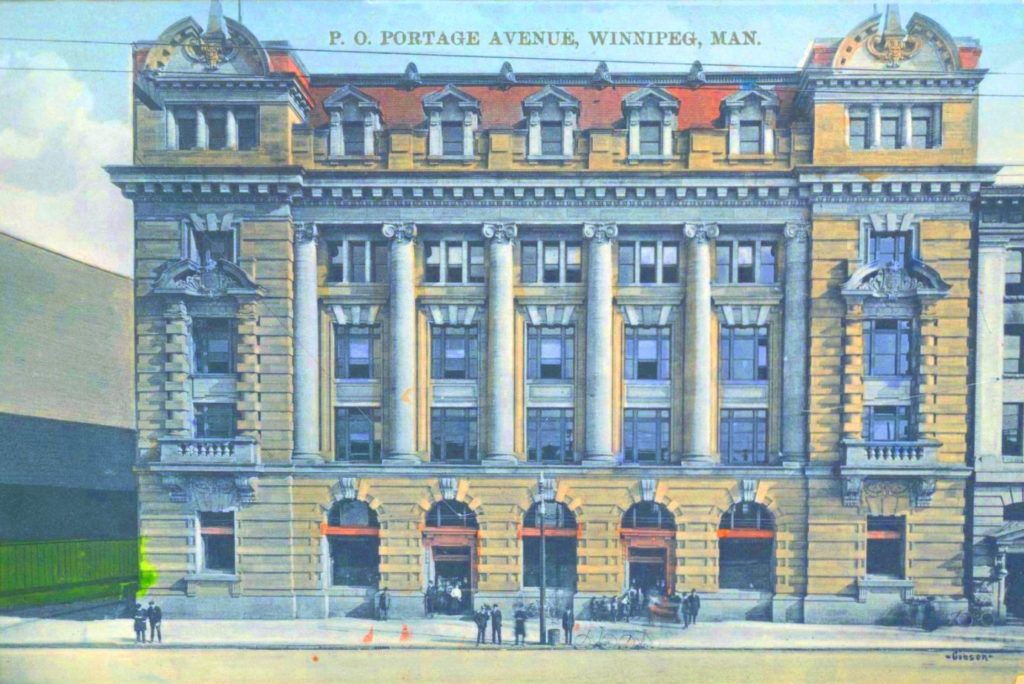
A postcard of Winnipeg’s 1908 post office on Portage Avenue, shortly after it was built.
Source: Martin Berman Postcard Collection (Winnipeg Public Library)
Winnipeg’s first post office was established in 1855 in the home of William Ross, the first postmaster in Western Canada. The home, Brookbank, was built in the Red River frame style between 1852 and 1855, near the Red River in what is now the east Exchange District. Letters were originally marked “Red River, B.N.A.” by Ross in place of stamps, and were sent monthly to Pembina, North Dakota, carried by horse in the summer or dogsled in the winter. After being moved twice, Ross House is now located in Joe Zuken Heritage Park, where it is open to the public as a museum in the summer. A municipal heritage designation also protects this part of our community’s heritage.
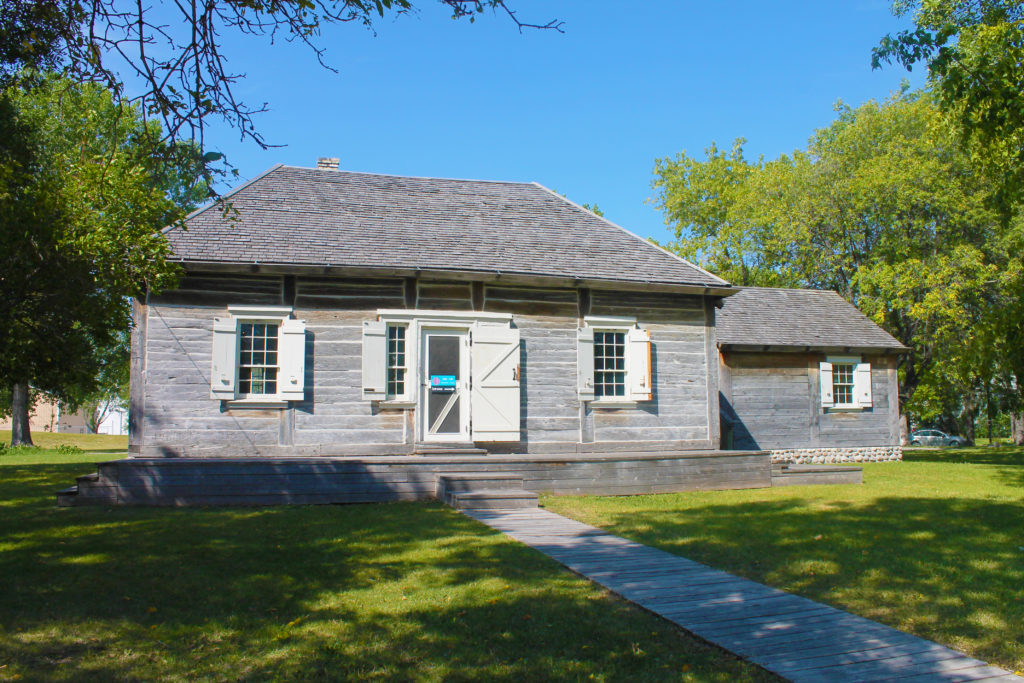
Ross House, Winnipeg’s first post office, is now a museum in Joe Zuken Heritage Park.
Source: Ross House Museum (Doors Open Winnipeg)
Winnipeg’s second post office opened its doors in 1871. It was located in a 168-square-foot room in the clapboard Commercial Hotel building on Lombard Avenue, which was originally called Post Office Street. The space could not accommodate the needs of a growing community for long, and a new building was constructed for Winnipeg’s third post office in 1876. Built of brick at the corner of McDermot Avenue and Main Street, it was also home to the Dominion Government Savings Bank. The post office would move to a temporary location further south down Main Street between 1883 and 1886, while the brick post office was replaced with a much larger building on the same site. Officially located at 401 Main Street, the new post office was a striking building with a striped facade featuring bands of stone and brick. After functioning as a post office, this building would be the Canada Customs Building before being used by the Wheat Pool. Unfortunately, the building was demolished in the early 1960s.
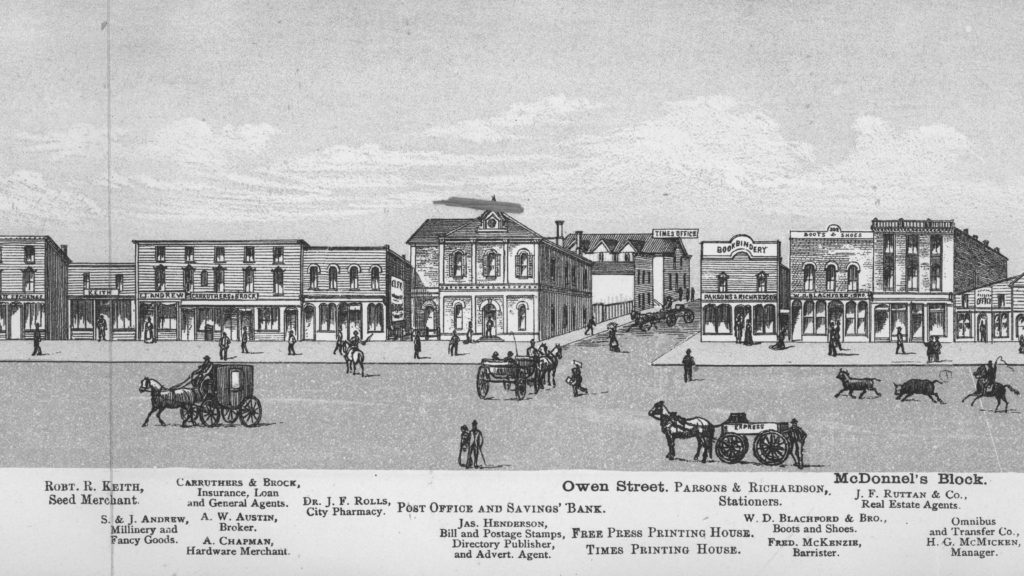
The east side of Main Street in 1881 with the 1876 post office building shown in the middle.
Source: Manitoba Historical Maps from Canada (CC BY 2.0, via Wikimedia Commons)
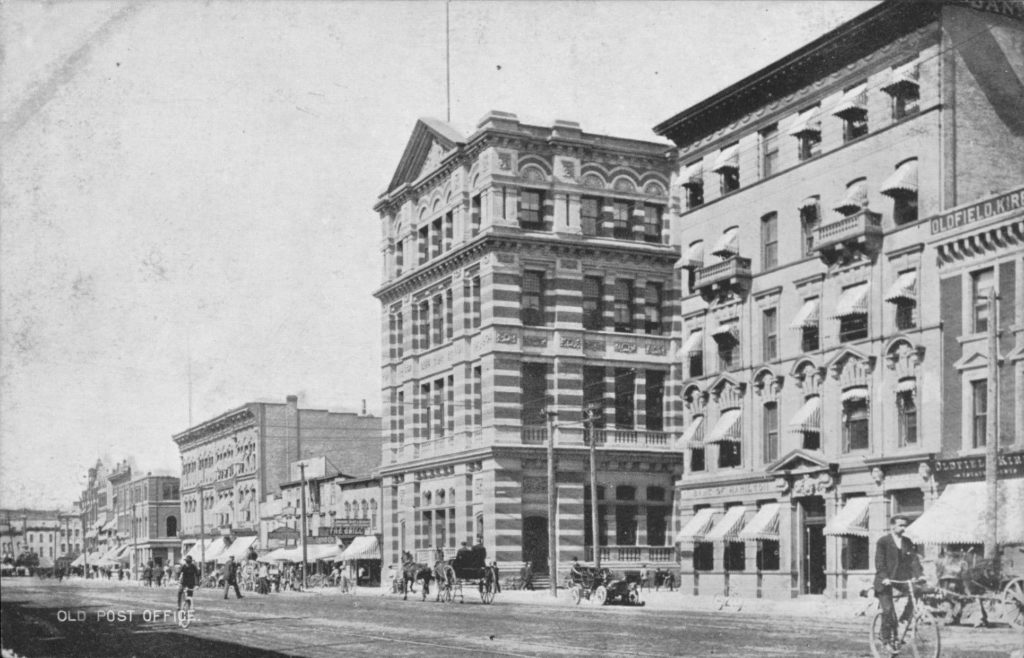
The east side of Main Street in the early 20th century with the 1886 post office building shown in the middle. This post office replaced the 1876 post office and was built in the same place.
Source: Martin Berman Postcard Collection (Winnipeg Pubic Library)
In 1908, Winnipeg’s post office relocated to a larger building once again, this time making a big move. After over fifty years in the Exchange District, the post office left the neighbourhood. It moved to Portage Avenue, leading the way as the commercial hub of the city shifted away from the intersection of Portage Avenue and Main Street. The post office was located between Fort Street and Garry Street, a couple blocks east of the iconic Eaton’s Department Store at 345 Portage Avenue, which had just opened in 1905. Winnipeg was a booming city on the prairies, and even with the big new post office, substations were being built throughout the city to manage the delivery of local mail. Small but beautifully designed, some of these early 20th-century post office buildings are still standing.

A postcard showing the south side of Portage Avenue, looking west from Fort Street some time between 1910 and 1914. The 1908 post office is on the left while the large building on the right with flags on the roof is Eaton’s Department Store.
Source: Martin Berman Postcard Collection (Winnipeg Pubic Library)
The grand post office on Portage Avenue was an ornate building designed in the French Renaissance style, costing about $750,000 to build. It was the vision of David Ewart, an incredibly prolific post office architect who worked for the Dominion Government. Ewart designed over 180 post offices from coast to coast in the late 19th and early 20th centuries, with his other Winnipeg location being a substation called “Winnipeg Postal Station B” at 1048 Main Street. The construction of the Postage Avenue post office would be supervised by the firm of Darling and Pearson, the premiere architectural office in all of Canada during the Edwardian era, setting the trends in bank design. Many outstanding buildings in Winnipeg from the early 20th century were the work of Darling and Pearson, including the monumental Bank of Commerce built between 1910 and 1912 at 389 Main Street, now the Millennium Centre.

A postcard of Winnipeg’s 1908 post office on Portage Avenue.
Source: Martin Berman Postcard Collection (Winnipeg Public Library)
After serving the community for 50 years as the post office, the Parcel Customs Department, the Dominion Lands Department, and the Federal Public Works Department, the Portage Avenue building was demolished in 1962. It was replaced with a new post office building at 266 Graham Avenue. Constructed between 1953 and 1958, this post office was designed by yet another outstanding architectural firm, Green, Blankstein, Russell, and Associates. The enormous modernist building was designed in two parts, a ten-story tower, and a four-storey low-rise section, together covering an entire city block. This time costing $11.5 million to build, the post office also housed various other federal offices. In 2008, Canada Post announced that it would be moving its facilities to the Winnipeg Airport, and vacating the Graham Avenue building. In 2016, the building reopened as the City of Winnipeg’s new Public Safety Building in a highly-scrutinized move. Although this building was adaptively reused, the former Public Safety Building, a significant modernist building in the Exchange District, was sadly demolished.
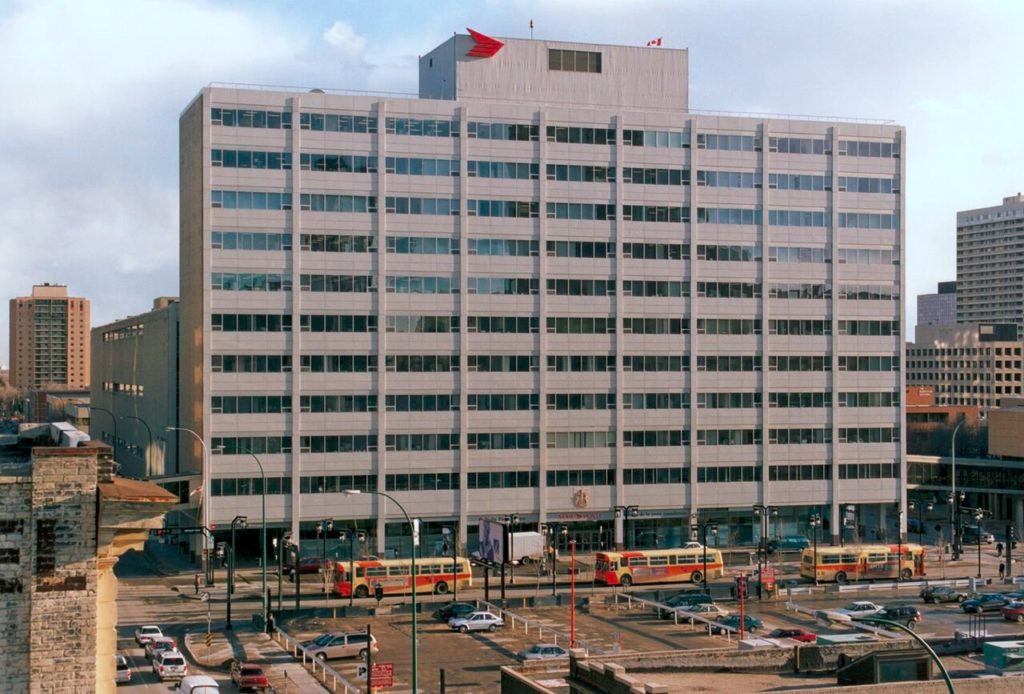
Winnipeg’s modernist post office at 266 Graham Avenue.
Source: Number Ten Architectural Group (CC BY-SA 4.0, via Wikimedia Commons)

Winnipeg’s mail processing plant is now located at the Winnipeg Airport, seen here in August 2018.
Source: Ken Lund from Reno, Nevada, USA (CC BY-SA 2.0, via Wikimedia Commons)
Although many of Winnipeg’s historical post offices have been relegated to memories, the function they served and some of the physical remnants remain. Shards from the Portage Avenue post office, large pieces of the limestone columns from the facade, were used to landscape Mostyn Park in 1990. Many of the postcards that once passed through the doors of Winnipeg’s post offices, conveying messages of joy and sorrow, hope and despair, love and loss on one side, with images of a bygone Winnipeg on the other side, also still exist. Fortunately, they were saved by individuals who recognized their importance in documenting our built and social history. Some postcards even show pictures of Winnipeg’s beautiful historic post offices!
-
A holiday postcard from Winnipeg showing views of Portage Avenue, the Sterling Bank Building, the Winnipeg General Hospital and the Lindsay Building.
Source: The Rob McInnes Postcard Collection (Winnipeg Public Library)
-
Back of the postcard.
Source: Martin Berman Postcard Collection (Winnipeg Public Library)
-
A holiday postcard showing Winnipeg’s Christmas decorations at Portage Avenue and Main Street in 1929.
Source: Martin Berman Postcard Collection (Winnipeg Public Library)
-
Back of the postcard.
Source: Martin Berman Postcard Collection (Winnipeg Public Library)
-
A holiday postcard from 1902 or 1903, showing Winnipeg’s Main Street, including the 1886 post office.
Source: The Rob McInnes Postcard Collection (Winnipeg Public Library)
-
Back of the postcard.
Source: The Rob McInnes Postcard Collection (Winnipeg Public Library)
-
A holiday postcard from Winnipeg showing a toboggan slide, ice cutting on Red River, St. John’s Park, skating and Central Park.
Source: The Rob McInnes Postcard Collection (Winnipeg Public Library)
-
Back of the postcard.
Source: The Rob McInnes Postcard Collection (Winnipeg Public Library)
-
A holiday postcard showing Winnipeg’s Christmas decorations looking southeast down Main Street from Portage Avenue in 1929.
Source: Martin Berman Postcard Collection (Winnipeg Public Library)
-
Back of the postcard.
Source: The Rob McInnes Postcard Collection (Winnipeg Public Library)
-
A holiday postcard showing Upper Fort Garry, Central Park, Portage Avenue, the Canadian Pacific Railway Station and Main Street.
Source: The Rob McInnes Postcard Collection (Winnipeg Public Library)
-
The back of the postcard
Source: The Rob McInnes Postcard Collection (Winnipeg Public Library)
Mixed in with the many postcards are holiday greetings, sending good cheer on specially designed cards, capturing Winnipeg’s finest buildings and beautiful Christmas lights. The first Christmas card was sent in 1843 by Henry Cole in the United Kingdom. Cole had played an important role in improving the British postal system, making sending mail efficient and affordable. As a result, seasonal mail became all the rage, inundating people with letters they did not have enough time to respond to. Cole’s solution with the Christmas card, a premade festive greeting that simply needed a “to” and “from” filled out. The trend of Christmas cards took some time to catch on, but it was firmly established when the first post office opened in Winnipeg in 1871.
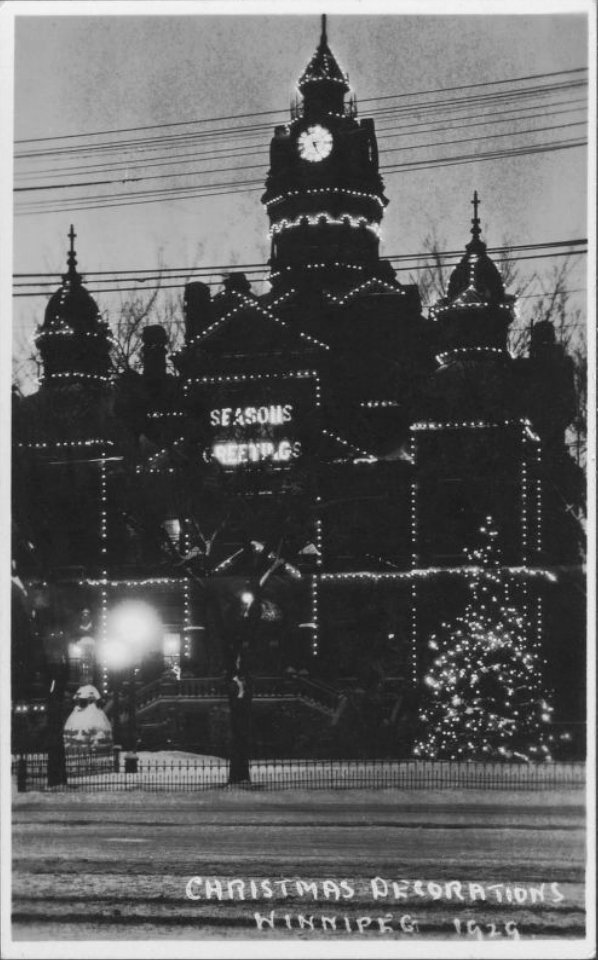
A postcard showing Winnipeg’s Gingerbread City Hall decorated for Christmas in 1929.
Source: Martin Berman Postcard Collection (Winnipeg Public Library)
While the buildings have changed and the systems inside have been drastically upgraded over the decades, post offices still play an important role in our lives, especially during this festive season. Mail helps us connect with the people we love, especially if we cannot see them in person, letting them know we care. Whether a humble cabin or a brand new multi-million dollar facility, Winnipeg’s post offices have made communication possible for nearly 170 years, bringing Winnipeg to the world and back again. As you put stamps on your cards and packages this holiday season, do not forget the historic buildings at the foundation of our mail system, spreading cheer, far and near!
THANK YOU TO THE SPONSOR OF THIS BLOG POST:

Written by Heritage Winnipeg.
SOURCES:
250 Years of Postal History | Canada Post Corporation - June 10, 2013
266 Graham Avenue | Winnipeg Architecture Foundation
Darling, Frank | Biographical Dictionary of Architects in Canada
Ewart, David | Biographical Dictionary of Architects in Canada
The first Christmas card | Victoria and Albert Museum
Oldest working post office | Guinness World Records - 2009
Pearson, John Andrew | Biographical Dictionary of Architects in Canada
postal system | Andrew C. Brix - Encyclopedia Britannica - December 3, 2023
Ross House Museum | Canada’s Historic Places - Parks Canada
Winnipeg’s Post Offices | Don Fraser - Manitoba Pageant - Spring 1974, Volume 19, Number 3





